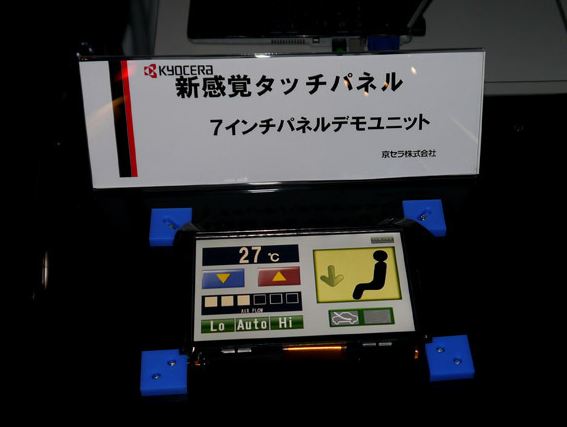
At last week’s Digital Contents Expo 2012 held in Tokyo, cutting edge technology company Kyocera unveiled something that will no doubt appeal to tablet and smartphone users the world over, potentially changing the way we use our modern-day gadgets forever.
The company has produced an intelligent touch screen that mimics a variety of sensations, from soft and squidy jelly, to rigid, clicky buttons. What does this mean for handsome folk you and me? It means all the speed and convenience of touch screens, but with fewer inaccuracies and silly– albeit amusing- typing mistakes. It could also mean that our beloved touch screens will become far more versatile in the future, not to mention becoming accessible to a much larger audience.
By now we’ve all had chance to play around with touch screens in some form or other. Since the birth of Apple’s iPhone, pretty much everyone and their mum can be seen tapping away at a handheld slab with a screen, and even modern-day computer operating systems have become so synonymous with touch-based input that many of us naturally assume that we can reach out and poke the screen to make something happen whether the feature is present or not.
Touch screens are undoubtedly convenient, but at times they can be awkward and, as anyone who’s tried ports of old games like Street Fighter 2 and Mega Man on a smart phone will know, incredibly inaccurate, often leaving us wishing we had at least a couple of physical buttons to press.
It looks like we may soon have the best of both worlds.
Using piezoelectric (piezo coming from the Greek for “push”) elements, the inside of the Kyocera’s new screens can be programmed to respond to different types of physical contact, in turn providing feedback that gives users the impression that they have touched or pressed down on something other than a simple glass screen. In simpler terms, a screen can be programmed to provide varying levels of resistance and mimic different textures.
Depending on the function or program, a single touch screen could at once feature squidgy buttons like bubble-wrap or even solid “clicks” like a light switch.
Imagine touching a link on a website and feeling the line of text sink into the screen by a millimetre or so, or switching off the alarm function on your phone every morning with a satisfying click. No more “I wonder why the page isn’t loading- maybe I didn’t click the link?” moments or fingers accidentally hitting keys on a virtual keyboard.
One of our reporters from RocketNews24 Japan had chance to try out the new touch screens at the expo last week and affirmed that this is no gimmick, saying:
“The buttons on the touch screen actually feel like like touching the real thing. Both older people who find virtual buttons tricky and who people who are get frsutrated by touch screens’ inaccuracies are sure to find this technology incredibly useful.”
The technology is likely to be implemented in everything from mobile phones and portables games consoles to in-car navigation panels and home electronics, and maker Kyocera estimates that up to 3 millions units featuring the screens will be available in the next five years.
Considering the amount of typos I make while using my iPhone, this writer at least is earnestly looking forward to the technology’s arrival. As much as we all love touch screens, physical buttons– be they for tapping out messages on a keyboard or helping an on-screen character jump– are sorely missed…
Source: ねとらぼ

 Play games on your touch screen the way they’re meant to be played with Buttons Anywhere
Play games on your touch screen the way they’re meant to be played with Buttons Anywhere Flipping genius? Japan is getting a new flip phone/smartphone hybrid【Photos】
Flipping genius? Japan is getting a new flip phone/smartphone hybrid【Photos】 7-Eleven Japan’s ramen-cooking robot whipped us up a bowl of noodles【Taste test】
7-Eleven Japan’s ramen-cooking robot whipped us up a bowl of noodles【Taste test】 Hello Kitty Choco Egg figures are an adorable trip through three periods of Japanese pop culture【Pics】
Hello Kitty Choco Egg figures are an adorable trip through three periods of Japanese pop culture【Pics】 Can a dirty butthole make you filthy rich in Japan? We’re starting a New Year’s lottery experiment
Can a dirty butthole make you filthy rich in Japan? We’re starting a New Year’s lottery experiment Japan’s otoshidama tradition of giving kids money at New Year’s gets a social welfare upgrade
Japan’s otoshidama tradition of giving kids money at New Year’s gets a social welfare upgrade Lacquerware supplier to emperor of Japan and Pokémon team up for new tableware
Lacquerware supplier to emperor of Japan and Pokémon team up for new tableware We suspected this Japanese cable car was an overpriced tourist trip, but we underestimated it
We suspected this Japanese cable car was an overpriced tourist trip, but we underestimated it New smartphone game lets you date real-life J-pop idols, but shockingly gives them 100 Boyfriends
New smartphone game lets you date real-life J-pop idols, but shockingly gives them 100 Boyfriends Seven unbelievable jobs that actually exist in Japan
Seven unbelievable jobs that actually exist in Japan More people in Japan quit sending New Year’s cards and many have started to regret it
More people in Japan quit sending New Year’s cards and many have started to regret it What’s a furisode kimono without sleeves? An incredibly elegant wedding dress【Photos】
What’s a furisode kimono without sleeves? An incredibly elegant wedding dress【Photos】 7-Eleven Japan starts new temporary luggage storage service in over 300 branches
7-Eleven Japan starts new temporary luggage storage service in over 300 branches Disillusionment at Tsukiji’s tourist-target prices led us to a great ramen restaurant in Tokyo
Disillusionment at Tsukiji’s tourist-target prices led us to a great ramen restaurant in Tokyo Starbucks teams up with 166-year-old Kyoto doll maker for Year of the Horse decorations【Photos】
Starbucks teams up with 166-year-old Kyoto doll maker for Year of the Horse decorations【Photos】 Japan may add Japanese language proficiency, lifestyle classes to permanent foreign resident requirements
Japan may add Japanese language proficiency, lifestyle classes to permanent foreign resident requirements Starbucks Japan releases new zodiac chilled cup drink for 2026
Starbucks Japan releases new zodiac chilled cup drink for 2026 Tokyo’s Tsukiji sushi neighborhood asks tour groups to stay away for the rest of the month
Tokyo’s Tsukiji sushi neighborhood asks tour groups to stay away for the rest of the month Is this the most relaxing Starbucks in Japan?
Is this the most relaxing Starbucks in Japan? Starbucks on a Shinkansen bullet train platform: 6 tips for using the automated store in Japan
Starbucks on a Shinkansen bullet train platform: 6 tips for using the automated store in Japan Street Fighter Hadouken Churros to be launched and eaten in Tokyo, Okami pudding on offer too
Street Fighter Hadouken Churros to be launched and eaten in Tokyo, Okami pudding on offer too Japan’s human washing machines will go on sale to general public, demos to be held in Tokyo
Japan’s human washing machines will go on sale to general public, demos to be held in Tokyo Japanese train company is letting fans buy its actual ticket gates for their homes
Japanese train company is letting fans buy its actual ticket gates for their homes Tokyo considering law requiring more trash cans following litter increase in heavily touristed area
Tokyo considering law requiring more trash cans following litter increase in heavily touristed area Nintendo’s Kirby now delivering orders at Kura Sushi restaurants, but not in Japan
Nintendo’s Kirby now delivering orders at Kura Sushi restaurants, but not in Japan Tokyo event lets you travel back in time, for free, to celebrate 100 years since Showa era start
Tokyo event lets you travel back in time, for free, to celebrate 100 years since Showa era start Sanrio theme park in Japan announces plans to expand into a Sanrio resort
Sanrio theme park in Japan announces plans to expand into a Sanrio resort Survey asks foreign tourists what bothered them in Japan, more than half gave same answer
Survey asks foreign tourists what bothered them in Japan, more than half gave same answer Japan’s deadliest food claims more victims, but why do people keep eating it for New Year’s?
Japan’s deadliest food claims more victims, but why do people keep eating it for New Year’s? We deeply regret going into this tunnel on our walk in the mountains of Japan
We deeply regret going into this tunnel on our walk in the mountains of Japan Studio Ghibli releases Kodama forest spirits from Princess Mononoke to light up your home
Studio Ghibli releases Kodama forest spirits from Princess Mononoke to light up your home Major Japanese hotel chain says reservations via overseas booking sites may not be valid
Major Japanese hotel chain says reservations via overseas booking sites may not be valid Put sesame oil in your coffee? Japanese maker says it’s the best way to start your day【Taste test】
Put sesame oil in your coffee? Japanese maker says it’s the best way to start your day【Taste test】 The top 10 annoying foreign tourist behaviors on trains, as chosen by Japanese people【Survey】
The top 10 annoying foreign tourist behaviors on trains, as chosen by Japanese people【Survey】 No more using real katana for tourism activities, Japan’s National Police Agency says
No more using real katana for tourism activities, Japan’s National Police Agency says Starbucks Japan reveals new sakura drinkware collection, inspired by evening cherry blossoms
Starbucks Japan reveals new sakura drinkware collection, inspired by evening cherry blossoms
Leave a Reply